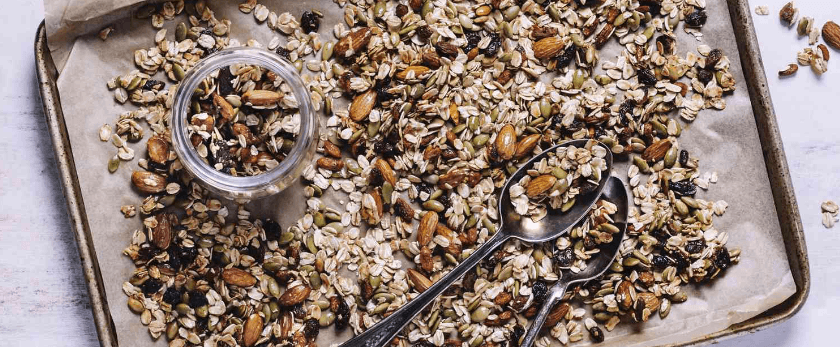Are you tired of buying store-bought granola that comes in plastic packaging and contains unnecessary additives? Look no further, because making your own granola at home is not only healthier and tastier, but it's also better for the environment. In this article, we'll explore why store-bought granola is bad for the environment, the benefits of making your own, and provide a simple recipe for you to try.
Why Store-Bought Granola is Bad for the Environment
1. Packaging Waste
One of the biggest issues with store-bought granola is the excessive packaging waste. Most granola comes in plastic bags or containers that are not recyclable or biodegradable. This means that they end up in landfills, where they can take hundreds of years to decompose. In addition, the production of plastic packaging contributes to the depletion of natural resources and the emission of greenhouse gases.
2. Transportation Emissions
Store-bought granola often travels long distances to reach your local grocery store. This means that it has a high carbon footprint due to the emissions from transportation. These emissions contribute to climate change and air pollution, which have negative impacts on the environment and human health.
3. Additives and Preservatives
Many store-bought granola brands contain additives and preservatives to prolong their shelf life and enhance their flavor. These additives can be harmful to both the environment and our health. For example, some preservatives have been linked to hormone disruption and other health issues. In addition, these additives can also end up in our waterways and harm aquatic life.
Why Making Your Own Granola is Better for the Environment
1. Reduces Packaging Waste
By making your own granola, you can significantly reduce packaging waste. You can store your homemade granola in reusable containers, such as glass jars or metal tins, instead of single-use plastic packaging. This not only reduces waste but also saves you money in the long run.
2. Uses Local and Organic Ingredients
When you make your own granola, you have control over the ingredients you use. You can choose to use locally sourced and organic ingredients, which have a lower carbon footprint and are better for the environment. By supporting local farmers and choosing organic ingredients, you are also promoting sustainable agriculture practices.
3. Customizable and Healthier
Making your own granola allows you to customize it to your liking. You can choose to add your favorite nuts, seeds, and dried fruits, and adjust the amount of sugar and oil used. This means you can make a healthier version of granola without any unnecessary additives or preservatives.
4. Reduces Carbon Footprint
By making your own granola, you are reducing the carbon footprint associated with transportation emissions. You can also choose to buy ingredients in bulk, which further reduces the carbon footprint of your granola. Additionally, making your own granola means you are not contributing to the demand for store-bought granola, which in turn reduces the need for production and transportation.

How to Make Homemade Granola
Ingredients:
- 3 cups rolled oats
- 1 cup chopped nuts (almonds, walnuts, pecans, etc.)
- 1/2 cup seeds (pumpkin, sunflower, chia, etc.)
- 1/2 cup dried fruit (raisins, cranberries, apricots, etc.)
- 1/4 cup honey or maple syrup
- 1/4 cup coconut oil
- 1 tsp vanilla extract
- 1 tsp cinnamon
- Pinch of salt
Instructions:
- Preheat your oven to 350°F (175°C).
- In a large mixing bowl, combine the rolled oats, chopped nuts, seeds, dried fruit, cinnamon, and salt.
- In a small saucepan, heat the honey or maple syrup, coconut oil, and vanilla extract over low heat until the coconut oil is melted.
- Pour the liquid mixture over the dry ingredients and mix well until everything is evenly coated.
- Spread the mixture onto a lined baking sheet and bake for 20-25 minutes, stirring halfway through, until the granola is golden brown.
- Let the granola cool completely before storing it in an airtight container.
Enjoy your homemade granola with your favorite milk or yogurt, or as a topping for smoothie bowls or ice cream.
Responsible Disposal of Ingredients
When making your own granola, it's important to also consider the responsible disposal of ingredients. Here are some tips to help you dispose of your ingredients in an eco-friendly way:
- Buy ingredients in bulk to reduce packaging waste.
- Choose ingredients that come in recyclable or biodegradable packaging.
- Compost any food scraps, such as fruit peels or nut shells.
- Reuse glass jars or metal tins to store your ingredients.
- Donate any excess ingredients to a local food bank or community organization.
In conclusion, making your own granola is not only a delicious and healthier option, but it's also better for the environment. By reducing packaging waste, using local and organic ingredients, and customizing your own recipe, you can make a positive impact on the planet. So next time you're craving granola, skip the store-bought version and try making your own. Your taste buds and the environment will thank you.










